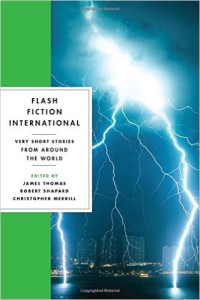Flash Fiction International
Flash Fiction International
Editors: James Thomas, Robert Shapard, Christopher Merrill
W.W. Norton & Co., 2015
288 pages
ISBN 978-0-393-34607-7
This year, James Thomas and Robert Shapard, the brilliant editors who brought us Flash Fiction Forward, New Sudden Fiction, and Sudden Fiction Latino (to name a few), have added a new anthology to their impressive stock: Flash Fiction International. As with some of their previous titles, this new book includes the duo’s familiar font and minimalist cover, but this time they’ve added editor Christopher Merrill from the University of Iowa’s International Writing Program. They’ve also added the rest of the world.
This is not, of course, the first time Thomas and Shapard have put together flash fiction from across the globe. In 1989, they produced Sudden Fiction International, which included work from Atwood, Borges, and Calvino. But even those who have been waiting thirty years will not be disappointed with this new addition to the series. With its diverse collection of authors, this is an ideal anthology not only for people new to the genre, but also for those familiar with the form, as each reader is sure to find a new voice among the represented authors.
One of the voices that is new to this series hails from Korea, a country which was left out of the first international collection when Thomas and Shapard were told by an editor in Seoul that a Korean flash writer might be hard to come by because “We Koreans are long-winded.” Luckily, they were able to find evidence that this is not always the case, and in this new collection we’re introduced to Kim Young-ha’s “Honor Killing,” a story largely focused on expectations in the workplace. It details the plight of a dermatologist’s assistant who is hired because of her perfect skin. When her skin loses its luster, she is forced to quit before, ultimately, committing suicide. With the metaphor of beauty as value magnified until the piece becomes almost allegorical, in some ways, this story is reminiscent of Steven Amick’s “Consumed” or Aimee Bender’s “The Rememberer.”
Of course, Young-ha’s story is just one of the many highlights in this collection. With such a range of styles, each reader is sure to have specific favorites, but I will touch on a few to which I was particularly drawn.
Peter Zaragoza Mayshle’s “Engkanto” is a raw piece which brings to mind Jamaica Kincaid’s “Girl” in its breathlessness, almost daring you to read it aloud. At approximately 300 words, it is only two full sentences: the first, a run through a painful memory, invoking confusion, fear, and innocence. The second, a seven-word declaration. The two together possibly represent the narrator’s long childhood and short adulthood.
Nuala Ní Chonchúir’s “The Egg Pyramid,” from Ireland, boasts insistent and painful prose with some humor woven throughout. The sonorous mix of these elements begs the reader to slow down to savor each sentence. 
Although, in the book’s last pages, Lauro Zavala argues that “Microfiction is the writing of the new millennium,” Shapard’s translation of Petronius’s “The Young Widow” seems to combat that idea. Including this piece from ancient Rome demonstrates that flash has been around for centuries, and it is certainly not just for those with one too many gadgets and not enough of an attention span. This story about love and loss is delivered effortlessly into 2015, and its upbeat cadence ends with an image that is striking and painful, sure to stay with readers long after they finish the rest of the book.
“Everyone Does Integral Calculus” by India’s Kuzhali Manickavel features a couple talking about their pasts and skillfully turns hair-bugs into things of beauty. There is a quiet innocence beginning with the title and continuing with poetic language which causes the reader to rethink the allure of notoriously unsavory visuals like head lice and roadkill. Throughout the narrative, Manickavel uses restrained prose, allowing small moments to pack big punches.
Kenya’s Eric Rugara encapsulates a father’s attempt to secure his family’s safety in “The Snake.” The continued efforts made by the father focus readers on the bond that brings this character’s family together. And, once the snake is defeated, the family members all share a thirst—and a subsequent tea, admirably demonstrating familial ties.
The US, too, is well-represented by American literary royalty like James Tate and Sherman Alexie alongside writers such as Meg Pokrass and Edward Mullany. The latter two, though well-known in flash fiction circles, have not yet had a platform to reach a wider audience. Being included in collections edited by Shapard and Thomas is exactly the kind of thing to give those talented authors additional exposure to a variety of new readers.
While I relished learning about so many new flash voices, as a teacher, I found that the truly unanticipated gem in this collection was the flash theory. With an eye towards the classroom, this section has dozens of quotes to help start discussions or debate the difference between flash fiction and prose poetry, assuming readers think there is one. For the first time in my life, I found myself thinking, “I’d love it if they included even more theory.” Here, again, the world has been incorporated, and we are offered insight from Ling Ku, Grace Paley, and Talat Abbasi.
I particularly enjoyed Robert Swartwood’s thoughts on flash: “For me, a very short story should do four basic things: obviously it should tell a story; it should be entertaining; it should be thought-provoking; and, if done well enough, it should invoke an emotional response.” Many of the pieces in this collection succeed on all four of these counts, and one can only look forward to whatever Thomas, Shapard, and Merrill will bring us next.
